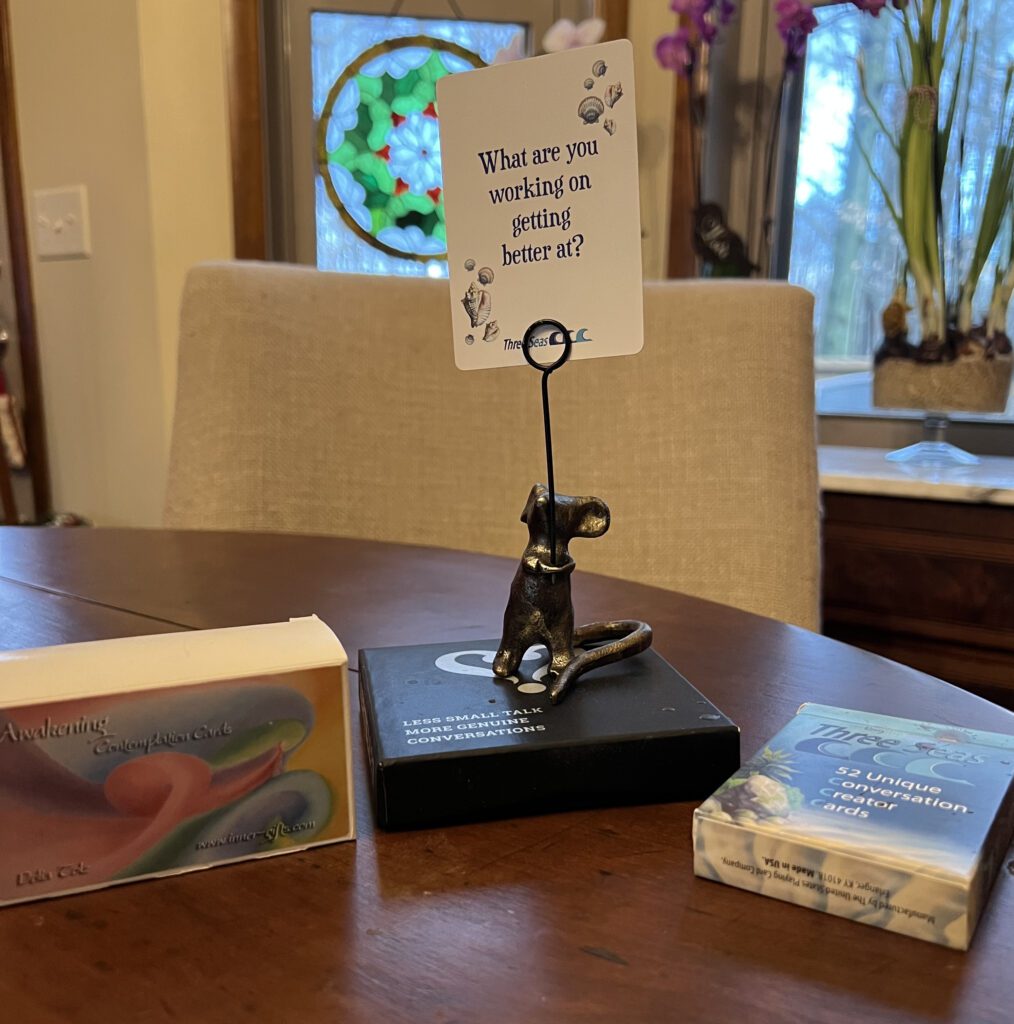Why share a story? While story sharing is not unique to human beings, our stories are unique to our lived experiences. Story sharing is essential to communication and expression. A shared life experience story helps others feel less alone and allows common ground and empathy for each other. Sharing a traumatic event helps us clarify what occurred and opens new approaches. Story sharing gives us space to consider all aspects of an issue, and we see our strengths and where we can improve. Sharing a story is a healthy way to gain perspective and learn.

Story sharing is a process of co-creation. A story shared takes on a life of its own in the listener. As we process what was said and take it into our lives, new possibilities awaken. We can learn a unique view of a problem, find humor in an overwhelming situation, and expand our human connection.
Stories are everywhere. As we experience events and interactions, we give them meaning and fit them into our lives and time flow. Our memories are fluid, and we adapt to new situations linking what we see before us to what we know from the past. These quick adaptations of the mind allow us to make sense of what we see and feel. At the same time, these quick adaptations can hide and obscure what is in front of us. One of the reasons to share a story is to lend form to what is often elusive and unidentified in us. The very process becomes one of reflection both of the listener and the speaker.
Finding the Story of an Emotion
Words are often inadequate as sensations and feelings are elusive and hard to capture. But the effort of searching and giving them form is freeing. Putting emotions into words allows a certain distance from the feeling and frees us to consider what is true and what is not.
Words are solid; they have form and weight. Emotions and feelings are unpredictable and changing, often flowing through us without acknowledging their presence. We feel uncomfortable but not the why of the discomfort. Stories help us discover the “why” of our feelings and connect to them differently within ourselves.
Some stories are beyond the scope of sharing. We may not know how to express our emotions. We may not even recognize what holds us back. The event may be too raw and personal to release with shared words. Silence is the place for these feelings, the silence of what seems too painful for others to comprehend.
Emotions and feelings can reveal themselves through reflection, meditation, and silence. To hear the nuances of emotions, expectations, and what is holding us back, we need to create space and silence within consciously. Sometimes the audience of self is all we need to find a deep connection self-to-Self.
Note to self: I should explain my use of self-to-Self. I am aware of mini-me, the self that takes things personally, runs amuck with self-justification, sees my life as the most crucial thing in the room, and generally sees only from my perspective. Luckily, mini-me is not satisfied with this confinement and seeks a connection with a larger-than-self Self. This Self is connected to the whole of life and reminds me I am one part of a whole that I do not understand but sense.
Meditation as Story Sharing
I have found that one person I do not listen to often is myself. When I discovered meditation, I learned to listen to the stories I tell myself.
There is a continuous, unconscious dialogue between my little self and my more extensive, more connected Self. Both have legitimate points of view that affect the way I perceive reality. These stories explain reality in terms of past experiences and judgments and often fail to connect to present possibilities.

We tell ourselves what we can and cannot do, not from experience but from thoughts that frequently are not ours. These stories alter our perception of what reality is. The moment viewed through fear is very different from the moment viewed through the eyes of curiosity. When fear is named and given form, it emotionally loses its power over us. We become aware. It is an oversimplification to imply that this realization is a permanent product, for realization changes and unfolds as we live. It is a continuous becoming.
We react and defend instead of listening and learning about ourselves. To hear the inner dialogue, I must create a space to listen. Meditation and reflection are a means to the silence needed.
Discursive meditation is a technique in Cafh where the story we tell is acknowledged, and we wait in silence to receive a more connected, expanded response. The response gives a broader connection to the whole.
Neal Donald Walsch wrote several books about a similar process, Conversations with God: An Uncommon Dialogue. In a talk, he shared that the most important point when he began was to first consider whether it was possible to have a conversation with God. To do a Discursive Meditation, first, assume it is possible to have a connection to a higher “Self” within you.
A short story:
You never know who hears the story or how it is understood. My dad said, “Don’t take yourself seriously, take Life seriously.” I created a whole story about that little phrase through the years. He said it when I could hear what he was saying, and I listened. I heard what was said, and applied it to different scenarios as I grew with the phrase. We are a small part of Life, but we are also life. That is what I came to understand.
Focus is challenging in a world of distractions. We need to be available and pay attention to hear the story beneath the casual interaction. In the car, there is the radio; at home, the television or computer, and always, the phone in hand. The obvious solution is to “put it down and turn it off,” silence a little bit of the noise we create from the outside to hear what is happening inside. Implementing this change in focus must be intentional but not too contrived.
Experience has shown me the best way to “slip in change” is to view it with the curiosity of an experiment. Just let it slide into place without directly challenging the habit. That recognition is often the beginning of the story. The playfulness allows for fun and surprises. I tell myself, “Let’s just give this a try and see what happens.” I have learned to keep it casual with my mental focus on what I intend. One of the first things is creating space within yourself to listen and share.
Begin with the fact that we all have a unique, unrepeatable story to tell of our life experiences. The topic, the words used, and the thought behind choosing a story reveal something about us.
Essential to story sharing is “Know your audience.”
The expectation of how others will respond is beyond the scope of story sharing, and we cannot possibly control this aspect. There is an art of choosing stories to share. While you cannot know the reaction of others to your story, you can be aware of your audience.
Here are some considerations before sharing a story.
- Is it an appropriate story to share?
- A story appropriate for an afternoon adventure in the woods might differ from one shared in a mixed group while eating.
- Is the timing a good one?
- Sometimes you want to share a story when people are too busy and occupied to hear what you are saying. Finding the time when people are available to listen is essential.
- Why do I want to share this story?
- If I want to share the story to convince or defend my way of thinking, then I am not sharing a story to connect. It is proselytizing. Stories can teach, illustrate, and entertain. Most of all, they can join us to each other.
- Does my story add to the conversation?
- A story that adds to the conversation allows the listener to feel connected. It adds awareness to both the storyteller and the listener.
- Is the audience receptive and available to hear my story?
- The time to share a story is outside of the frenetic activity. Wait for the moment when there is space for sharing, and the audience can pay attention.
- Am I using words that are connecting?
- Some words and approaches are closed and reveal that we are not willing to share a story, we only want to tell our view.
Sharing Our Unique Story
How often do we share the unique perspective story, not the cursory “My name is… I live in …. and I work at ….” but the adventure process to the creation of your thoughts, what you do, and who you are at this moment.
Spaces abound for sharing a story, a sentence here, a visual there scattered throughout the day. Do our stories resonate in silence when we do not share them? What makes for a good story? Does the lesson illustrate a parable-like tale that transcends time and place? Are there tones of voice used to give interest to the different characters? Why is the story being shared?
Storytelling occurs at any opportune moment. There are moments throughout the day and night offering a chance to share a story and listen to another’s. Take the opportunity to share and listen to each other; this human interaction is connecting. Begin with the fact that we all have a unique, unrepeatable story to tell of our life experiences. The topic, the words used, and the thought behind choosing a story reveal something about us.
All these questions and more come to my mind as I consider the role of storytelling and sharing. The space needed for sharing is available to everyone; it just must be intentional at first. I realized the need to begin at home.
My family is consciously implementing the pause of sharing stories at the dinner table. It is an effort of generational connection, cultural sharing, and learning that everyone has a story to share. Some people hold their stories close and are not comfortable with sharing. It is important to allow each space to participate in their comfort zone. I have found it helpful to have “story starters” that are very neutral and easy to connect.
Table Talk: It’s in the Cards

The desire for connection around the table has become quite popular. As we become aware of the need for involvement so that one person does not dominate the table talk, some tools are available to purchase or even to create.
Put “conversation cards” into google, and you quickly find a wide range of games and cards readily available. Or make your own with a pen and paper and the imagination of topics of the day. All ages can answer and elaborate on a wide range of issues. How about a discussion on “When was the last time you had a good laugh? And why?” “What is something you learned today?” “What is the most useful thing you own?” “If there were a fire in your house, what would be the first thing you would want to save?” “What is the favorite thing about the person sitting next to you?”
My grandchildren enjoy our “story time” questions of the day. They take turns reading through the card deck of conversation starters and pick what they would like to share. It has become a ceremonial effort as the “mouse” holds the conversation card selected. There are aspects of why I chose to set the stage for the conversation this way. The children become active participants and have the role of choosing and reading the cards. They get to turn the conversation and storytelling into a ceremonial game of connection. Most importantly, it allows them to hear their voice and share their thoughts with a larger audience. They are valued.
Shared Stories
It is vital that everyone feel comfortable telling a story or sharing; frankly, this is only sometimes the case. For some people, the stories have not formed into words. These are emotions and feelings, sensations that defy the weight of words. Those stories remain locked within, waiting for time to bring them forth. Some of these stories are isolating to the core of us, and we think we alone have ever felt this way and hold the story tight around us.
By far, most of the stories we share are the surface-skipping ones of name, place of birth, and what we “do” for a living. What moves beyond this surface conversation can come from simple questions and redefining yourself. It comes as much from listening to another’s story as from questioning our own. Like Facebook and Instagram, we put our best face forward.
These stories can be for humor, to teach, or for the joy of creating. You must be aware of the audience and gather the feedback they are giving you. When speaking with the audience in mind allows one to consider the listener while telling the story.
There is an art to storytelling that is part of daily life. A story that is ours comes from our lived experience. Sharing a story of your experience connects you to your inner self and your basic humanity and helps contextualize the experience.

Life’s unfolding story is like the spiral found in nature; it begins with me, my realization, and my story, but as it includes others, it spirals out.
Dialogue is a shared story.
About the Author(s)
Libbie is a graduate of Ohio State University where her degree has proven a flexible base for writing, teaching, and exploring life. She facilitates the weekly Sunday eDialogue.





